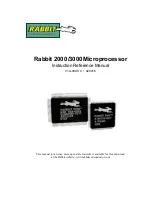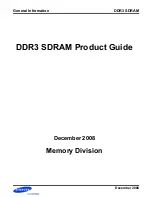
Thermal Specifications
56
Thermal/Mechanical Specifications and Design Guidelines
6.2.2.4
Critical Temperature Flag
If TM2 is unable to reduce the processor temperature, then TM1 will be also be
activated. TM1 and TM2 will then work together to reduce power dissipation and
temperature. It is expected that only a catastrophic thermal solution failure would
create a situation where both TM1 and TM2 are active.
If TM1 and TM2 have both been active for greater than 20ms and the processor
temperature has not dropped below the TCC activation point, then the Critical
Temperature Flag in the IA32_THERM_STATUS MSR will be set. This flag is an indicator
of a catastrophic thermal solution failure and that the processor cannot reduce its
temperature. Unless immediate action is taken to resolve the failure, the processor will
probably reach the Thermtrip temperature (see
a short time. In order to prevent possible permanent silicon damage, Intel
recommends removing power from the processor within ½ second of the Critical
Temperature Flag being set
6.2.2.5
PROCHOT# Signal
An external signal, PROCHOT# (processor hot), is asserted when the processor core
temperature has exceeded its specification. If Adaptive Thermal Monitor is enabled
(note it must be enabled for the processor to be operating within specification), the
TCC will be active when PROCHOT# is asserted.
The processor can be configured to generate an interrupt upon the assertion or de-
assertion of PROCHOT#.
Although the PROCHOT# signal is an output by default, it may be configured as bi-
directional. When configured in bi-directional mode, it is either an output indicating the
processor has exceeded its TCC activation temperature or it can be driven from an
external source (such as, a voltage regulator) to activate the TCC. The ability to
activate the TCC via PROCHOT# can provide a means for thermal protection of system
components.
As an output, PROCHOT# (Processor Hot) will go active when the processor
temperature monitoring sensor detects that one or more cores has reached its
maximum safe operating temperature. This indicates that the processor Thermal
Control Circuit (TCC) has been activated, if enabled. As an input, assertion of
PROCHOT# by the system will activate the TCC for all cores. TCC activation when
PROCHOT# is asserted by the system will result in the processor immediately
transitioning to the minimum frequency and corresponding voltage (using Freq/VID
control). Clock modulation is not activated in this case. The TCC will remain active until
the system de-asserts PROCHOT#.
Use of PROCHOT# in bi-directional mode can allow VR thermal designs to target
maximum sustained current instead of maximum current. Systems should still provide
proper cooling for the VR, and rely on PROCHOT# only as a backup in case of system
cooling failure. The system thermal design should allow the power delivery circuitry to
operate within its temperature specification even while the processor is operating at its
Thermal Design Power.
6.2.3
THERMTRIP# Signal
Regardless of whether or not Adaptive Thermal Monitor is enabled, in the event of a
catastrophic cooling failure, the processor will automatically shut down when the silicon
has reached an elevated temperature (refer to the THERMTRIP# definition in the EDS).
At this point, the THERMTRIP# signal will go active and stay active as described in the
EDS. THERMTRIP# activation is independent of processor activity. If THERMTRIP# is
asserted, processor core voltage (V
CC
) must be removed within the timeframe defined
in EDS. The temperature at which THERMTRIP# asserts is not user configurable and is
not software visible.
Summary of Contents for 2ND GENERATION CORE PROCESSOR FAMILY DESKTOP - THERMAL MECHANICAL S AND DESIGN GUIDELINES 01-2011
Page 12: ...Introduction 12 Thermal Mechanical Specifications and Design Guidelines...
Page 36: ...Independent Loading Mechanism ILM 36 Thermal Mechanical Specifications and Design Guidelines...
Page 62: ...PECI Interface 62 Thermal Mechanical Specifications and Design Guidelines...
Page 88: ...ATX Reference Thermal Solution 88 Thermal Mechanical Specifications and Design Guidelines...
Page 102: ...Boxed Processor Specifications 102 Thermal Mechanical Specifications and Design Guidelines...
Page 120: ...Mechanical Drawings 120 Thermal Mechanical Specifications and Design Guidelines...
Page 126: ...Socket Mechanical Drawings 126 Thermal Mechanical Specifications and Design Guidelines...
Page 130: ...Package Mechanical Drawings 130 Thermal Mechanical Specifications and Design Guidelines...














































